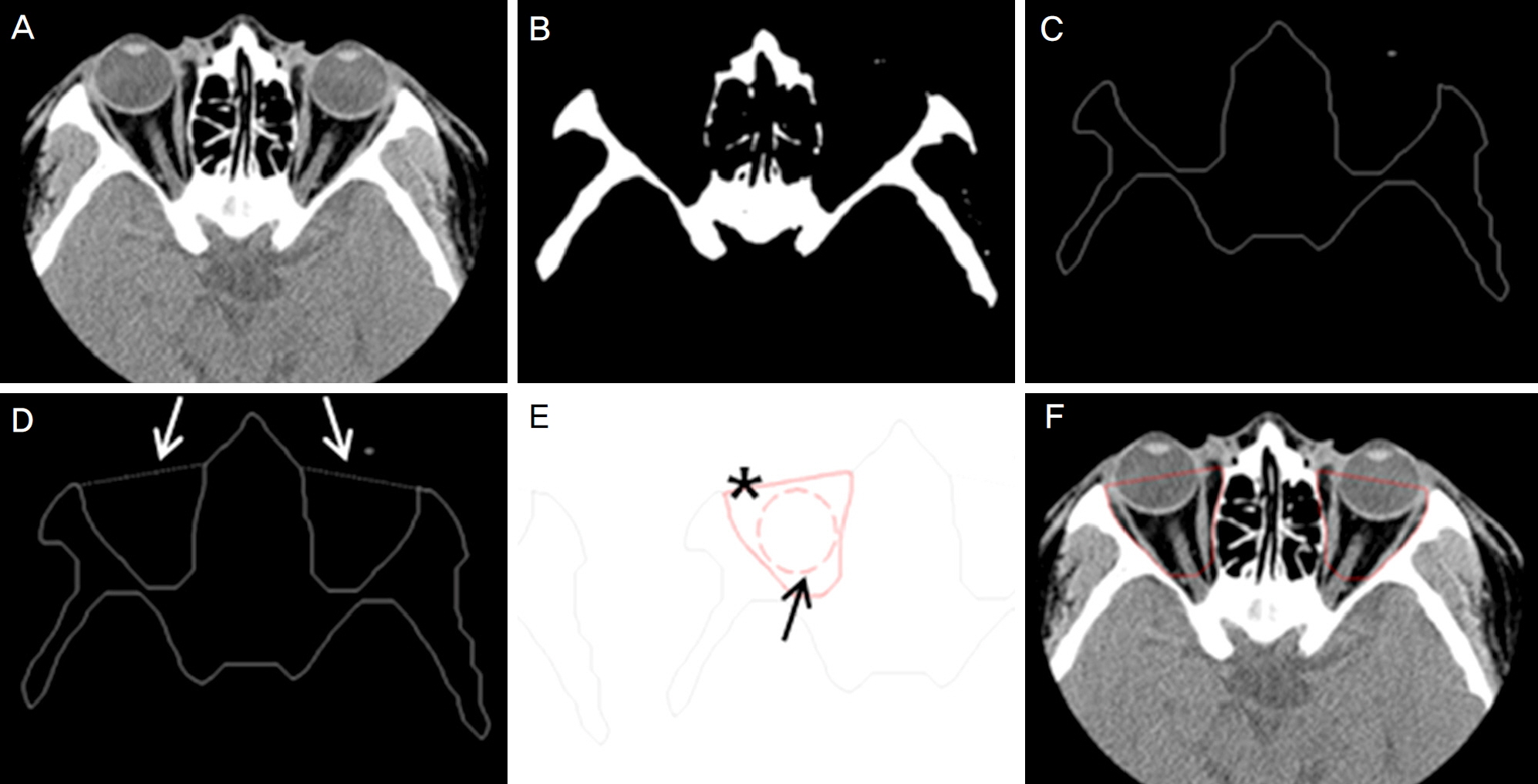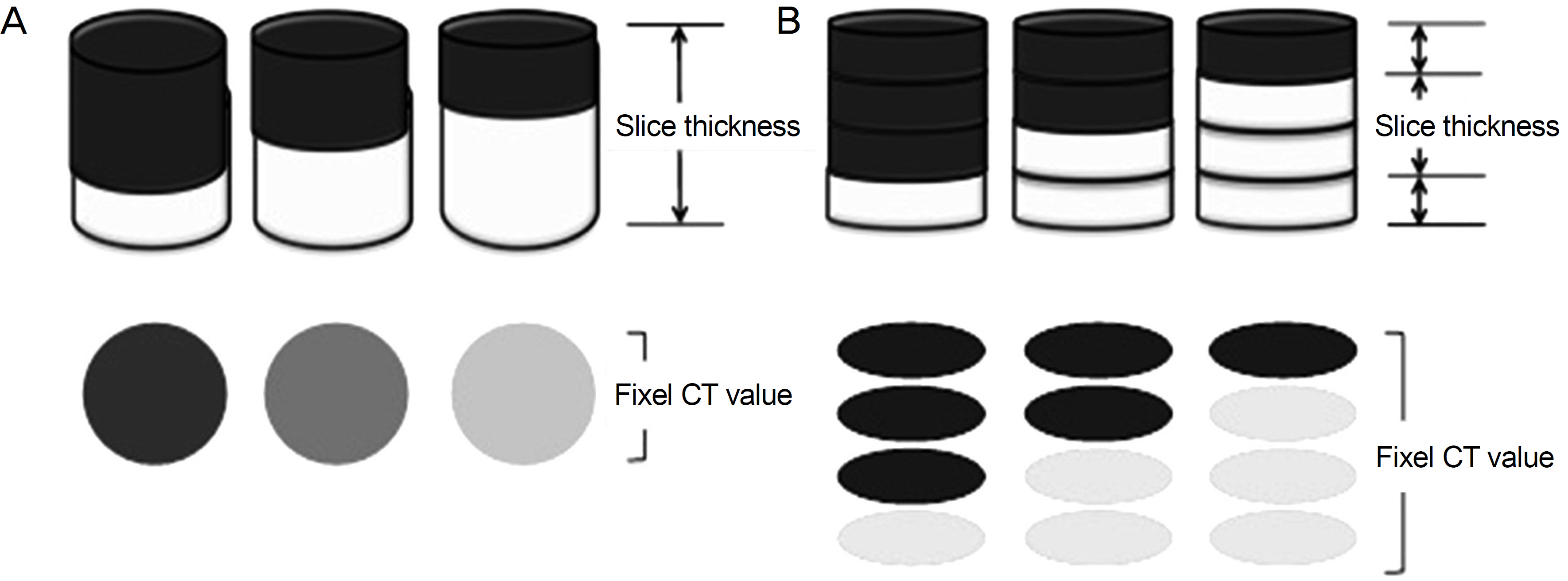J Korean Ophthalmol Soc.
2016 Nov;57(11):1671-1677. 10.3341/jkos.2016.57.11.1671.
Measurement of Orbital Volume from Different Slice Thickness Facial Computed Tomography Scans Using a Semi-automatic Program
- Affiliations
-
- 1Department of Ophthalmology, Kyung Hee University Hospital at Gangdong, Kyung Hee University School of Medicine, Seoul, Korea. pbloadsky@naver.com
- 2Department of Ophthalmology, Myongji Hospital, Seonam University College of Medicine, Goyang, Korea.
- 3Department of Ophthalmology, Kyung Hee University Hospital, Kyung Hee University School of Medicine, Seoul, Korea.
- 4Department of Bioengineering, Kyung Hee University School of Medicine, Seoul, Korea.
- KMID: 2357720
- DOI: http://doi.org/10.3341/jkos.2016.57.11.1671
Abstract
- PURPOSE
To compare the orbital volume calculated from various slice thickness facial computed tomography scans using a semi-automated computer program.
METHODS
Axial and coronal scans of 2, 2.5, 3 mm slice thickness facial computed tomography scans were used to measure the orbital volume. The cross-sectional area was determined from each slice using a semi-automated computer program (MATLAB 2009a®, MathWorks, Inc., Natick, MA, USA), and then the volume was calculated from serial reconstruction of the cross sections.
RESULTS
The measured value in the 2 mm images was 33.14 ± 2.37 cm³ in the right orbit and 34.32 ± 2.60 cm³ in the left orbit for the axial scans, and 35.54 ± 3.58 cm³ in the right orbit and 34.96 ± 4.05 cm³ in the left orbit for the coronal scans. In the 2.5 mm images, the values were 33.28 ± 3.35 cm³ in the right orbit and 33.73 ± 4.10 cm³ in the left orbit for the axial scans, and 35.24 ± 3.98 cm³ in the right orbit and 35.10 ± 3.93 cm³ in the left orbit for the coronal scans. In the 3 mm images, the values were 33.23 ± 2.70 cm³ in the right orbit and 33.39 ± 2.69 cm³ in the left orbit for the axial scans, and 33.20 ± 3.64 cm³ in the right orbit and 32.95 ± 3.45 cm³ in the left orbit for the coronal scans. In the 3 mm image, there was not a significant difference in the calculated volume between the axial and coronal scans (p(3mm) = 0.62).
CONCLUSIONS
Because there is no difference in the results of the orbital volumetric measurements between three other slice thicknesses in the axial scan, using axial scan images with a computer program that semi-automatically calculates orbital volume is useful. In addition, the volume measured by thick slice images has more reproducibility than the volume measured by thin slice images.
MeSH Terms
Figure
Reference
-
References
1. Phillips PH. The orbit. Ophthalmol Clin North Am. 2001; 14:109–27.2. Cooper WC. A method for volume determination of the orbit and its contents by high resolution axial tomography and quantitative digital image analysis. Trans Am Ophthalmol Soc. 1985; 83:546–609.3. Ellis E 3rd, Tan Y. Assessment of internal orbital reconstructions for pure blowout fractures: cranial bone grafts versus titanium mesh. J Oral Maxillofac Surg. 2003; 61:442–53.
Article4. Burres SA, Cohn AM, Mathog RH. Repair of orbital blowout abdominal with Marlex mesh and Gelfilm. Laryngoscope. 1981; 91:1881–6.5. Gellrich NC, Schramm A, Hammer B, et al. Computer-assisted secondary reconstruction of unilateral posttraumatic orbital deformity. Plast Reconstr Surg. 2002; 110:1417–29.
Article6. Jansen J, Schreurs R, Dubois L, et al. Orbital volume analysis: abdominal of a semi-automatic software segmentation method. Int J Comput Assist Radiol Surg. 2016; 11:11–8.7. Deveci M, Oztürk S, Sengezer M, Pabuş cu Y. Measurement of abdominal volume by a 3-dimensional software program: an Experimental Study. J Oral Maxillofac Surg. 2000; 58:645–8.8. Koppel DA, Foy RH, McCaul JA, et al. The reliability of “Analyze” software in measuring orbital volume utilizing CT-de-rived data. J Craniomaxillofac Surg. 2003; 31:88–91.
Article9. Regensburg NI, Kok PH, Zonneveld FW, et al. A new and validated CT-based method for the calculation of orbital soft tissue volumes. Invest Ophthalmol Vis Sci. 2008; 49:1758–62.
Article10. Choi JH, Park IK, Choi SJ, Shin JH. Measurement of orbital abdominal from facial CT scans using a semi-automatic computer program. J Korean Ophthalmol Soc. 2015; 56:168–73.11. Ye J, Kook KH, Lee SY. Evaluation of computer-based volume measurement and porous polyethylene channel implants in abdominal of large orbital wall fractures. Invest Ophthalmol Vis Sci. 2006; 47:509–13.12. Forbes G, Gorman CA, Gehring D, Baker HL Jr. Computer abdominal of orbital fat and muscle volumes in Graves ophthalmopathy. AJNR Am J Neuroradiol. 1983; 4:737–40.13. Trokel SL, Jakbiec FA. Correlation of CT scanning and pathologic features of ophthalmic Graves' disease. Ophthalmology. 1981; 88:553–64.
Article14. Xi W, Perdanasari AT, Ong Y, et al. Objective breast volume, shape and surface area assessment: a systematic review of breast abdominal methods. Aesthetic Plast Surg. 2014; 38:1116–30.15. Kwon J, Barrera JE, Most SP. Comparative computation of orbital volume from axial and coronal CT using three-dimensional image analysis. Ophthal Plast Reconstr Surg. 2010; 26:26–9.
Article16. Bite U, Jackson IT, Forbes GS, Gehring DG. Orbital volume abdominals in enophthalmos using three-dimensional CT imaging. Plast Reconst Surg. 1985; 75:502–8.17. Frericks BB, Caldarone FC, Nashan B, et al. 3D CT modeling of hepatic vessel architecture and volume calculation in living do-nated liver transplantation. Eur Radiol. 2004; 14:326–33.
Article18. Hori M, Suzuki K, Epstein ML, Baron RL. Computed tomography liver volumetry using 3-dimensional image data in living donor liver transplantation: effects of the slice thickness on the volume calculation. Liver Transpl. 2011; 17:1427–36.
Article19. Reiner CS, Karlo C, Petrowsky H, et al. Preoperative liver abdominal: how does the slice thickness influence the multidetector abdominal tomography- and magnetic resonance-liver volume abdominals? J Comput Assist Tomogr. 2009; 33:390–7.20. Berthelet E, Liu M, Truong P, et al. CT slice index and thickness: impact on organ contouring in radiation treatment planning for prostate cancer. J Appl Clin Med Phys. 2003; 4:365–73.
Article21. Winer-Muram HT, Jennings SG, Meyer CA, et al. Effect of varying CT section width on volumetric measurement of lung tumors and application of compensatory equations. Radiology. 2003; 229:184–94.
Article22. Petrou M, Quint LE, Nan B, Baker LH. Pulmonary nodule abdominal measurement variability as a function of CT slice thickness and nodule morphology. AJR Am J Roentgenol. 2007; 188:306–12.23. Jurij RB, Frederick AJ. Embryology and Anatomy of the Orbit and Lacrimal System. Tasman W, Jaeger EA, editors. Duane's Ophthalmology. Philadelphia: Lippincott Williams & Wilkins;2007. chap. 32.24. Kim TH, Jun HS, Byun YJ. The normal value of adult Korean abdominal volume in three-dimensional computerized tomography. J Korean Ophthalmol Soc. 2001; 42:1011–5.
- Full Text Links
- Actions
-
Cited
- CITED
-
- Close
- Share
- Similar articles
-
- Measurement of Orbital Volume from Facial CT Scans Using a Semi-Automatic Computer Program
- Semi-automatic Measurement of Ocular Volume from Facial Computed Tomography and Correlation with Axial Length
- A study of Parameters in Spiral CT Volumetry Using Balloon Phantoms
- Clinical usefulness of facial soft tissues thickness measurement using 3D computed tomographic images
- Effect of variable scanning protocolson the pre-implant site evaluation of the mandiblein reformatted computed tomography





